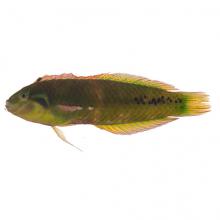Novaculoides macrolepidotus
Common name:
Seagrass wrasse
Genus:
Novaculoides
Family:
Labridae
Suborder:
Labroidei
Choerodon fasciatus
Common name:
Harlequin tuskfish
Genus:
Choerodon
Family:
Labridae
Suborder:
Labroidei
Novaculoides macrolepidotus
Common name:
Seagrass wrasse
Genus:
Novaculoides
Family:
Labridae
Suborder:
Labroidei
Choerodon fasciatus
Common name:
Harlequin tuskfish
Genus:
Choerodon
Family:
Labridae
Suborder:
Labroidei
Novaculoides macrolepidotus
Common name:
Seagrass wrasse
Genus:
Novaculoides
Family:
Labridae
Suborder:
Labroidei
Choerodon fasciatus
Common name:
Harlequin tuskfish
Genus:
Choerodon
Family:
Labridae
Suborder:
Labroidei
Family (Animalia): Labridae
The wrasses are a family, Labridae, of marine fish, many of which are brightly colored. The family is large and diverse, with over 600 species in 81 genera, which are divided into 9 subgroups or tribes. They are typically small fish, most of them less than 20 cm (7.9 in) long, although the largest, the humphead wrasse, can measure up to 2.5 m (8.2 ft). They are efficient carnivores, feeding on a wide range of small invertebrates. Many smaller wrasses follow the feeding trails of larger fish, picking up invertebrates disturbed by their passing. Juveniles of some representatives of the genera Bodianus, Epibulus, Cirrhilabrus, Oxycheilinus, and Paracheilinus hide among the tentacles of the free-living mushroom corals & Heliofungia actiniformis.
Anatomy
Wrasses have protractile mouths, usually with separate jaw teeth that jut outwards.[8] Many species can be readily recognized by their thick lips, the inside of which is sometimes curiously folded, a peculiarity which gave rise the German name of "lip-fishes" (Lippfische).[9] and the Dutch name of lipvissen. The dorsal fin has eight to 21 spines and six to 21 soft rays, usually running most of the length of the back. Wrasses are sexually dimorphic. Many species are capable of changing sex. Juveniles are a mix of males and females (known as initial-phase individuals), but the largest adults become territory-holding (terminal-phase) males.
The wrasses have become a primary study species in fish-feeding biomechanics due to their jaw structures. The nasal and mandibular bones are connected at their posterior ends to the rigid neurocranium, and the superior and inferior articulations of the maxilla are joined to the anterior tips of these two bones, respectively, creating a loop of four rigid bones connected by moving joints. This "four-bar linkage" has the property of allowing numerous arrangements to achieve a given mechanical result (fast jaw protrusion or a forceful bite), thus decoupling morphology from function. The actual morphology of wrasses reflects this, with many lineages displaying different jaw morphology that results in the same functional output in a similar or identical ecological niche.
The word "wrasse" comes from the Cornish word wragh, a lenited form of gwragh, meaning an old woman or hag, via Cornish dialect wrath. It is related to the Welsh gwrach and Breton gwrac'h.
Reference: Wikipedia


